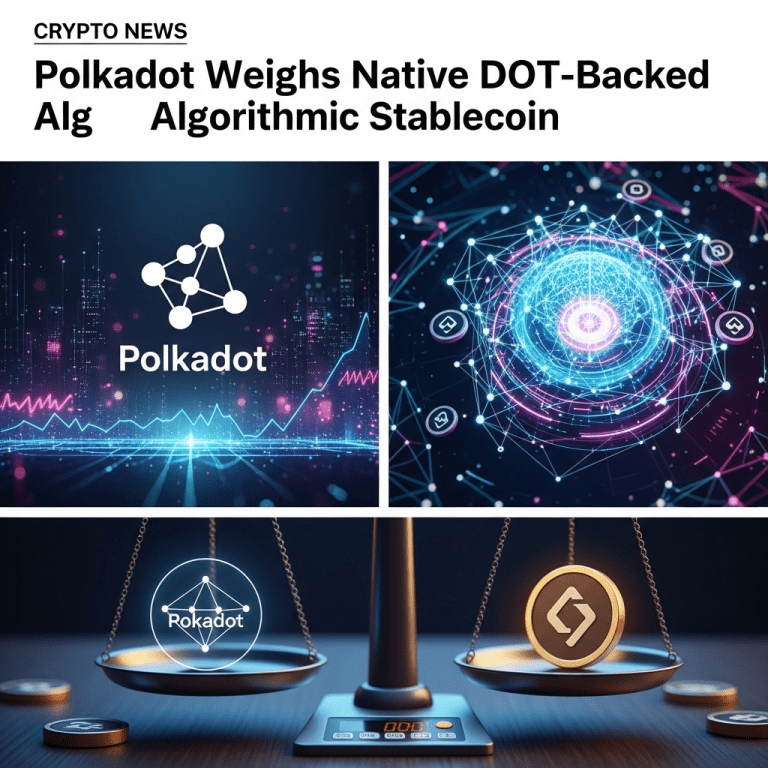Amid growing demand for innovative stable assets, Polkadot weighs native DOT-backed algorithmic stablecoin as part of its roadmap for progressive decentralized finance in 2025. This bold move could reshape stablecoin dynamics and give Polkadot a pivotal new utility in both its ecosystem and the wider crypto landscape.
Why Polkadot Weighs Native DOT-Backed Algorithmic Stablecoin in 2025
The interest in a native stablecoin is spurred by persistent challenges with mainstream stablecoins, including regulatory scrutiny, centralization, and periodic depegging events. As DeFi users continue to seek alternatives to centralized offerings, Polkadot is evaluating the feasibility of an on-chain, algorithmically managed stablecoin collateralized by its native DOT tokens. This approach would leverage Polkadot’s robust interoperability, parachain architecture, and on-chain governance to pioneer a secure, transparent, and highly scalable stable asset.
How Algorithmic Stablecoins Operate
Algorithmic stablecoins utilize smart contracts and supply controls, rather than fiat reserves, to maintain price stability. By dynamically adjusting the circulating supply—minting or burning in response to demand—algorithmic models aim to retain a peg, often to the US dollar or other stable currencies. In the DOT-backed model, the value would be stabilized using DOT as reserve collateral, with mechanisms to maintain equilibrium even during market volatility.
Benefits of a DOT-Backed Stablecoin for Polkadot
By launching its own algorithmic stablecoin, Polkadot could unlock new growth levers:
- Ecosystem Incentives: Native stablecoins enhance DeFi protocols on Polkadot by offering reliable, ecosystem-specific liquidity.
- Capital Efficiency: Utilizing DOT as collateral keeps value circulating within the network, boosting staking, lending, and yield farming.
- Risk Mitigation: With on-chain transparency and decentralized governance, algorithmic stablecoins can provide improved resistance to black swan events and single-point failures.
Also, a DOT-backed mechanism aligns incentives among network participants, potentially driving greater DOT demand and fortifying the token’s utility beyond staking and governance.
Challenges and Considerations for Polkadot’s Algorithmic Stablecoin
Despite the promise, history offers cautionary tales. Algorithmic stablecoins have experienced spectacular failures—highlighted by high-profile depegs—when maintenance mechanisms were insufficiently robust. For Polkadot, the challenge will be to design a system that can resist market shocks and speculative attacks, ensuring the stablecoin remains truly stable.
Governance and Decentralization
Polkadot’s on-chain governance framework provides an edge; DOT holders can vote on key parameters such as collateral ratios, monetary policy adjustments, and risk controls. This democratic process would foster collective stewardship, potentially making the stablecoin more resilient and adaptable than centralized peers.
Regulatory Landscape in 2025
Global regulatory attention on stablecoins is intensifying as adoption accelerates. While algorithmic coins may initially skirt direct fiat-backing concerns, scrutiny is rising on their operational transparency, collateral sufficiency, and potential systemic risks. As Polkadot weighs native DOT-backed algorithmic stablecoin, regulatory adaptability will be crucial. The project must anticipate audits, compliance standards, and potential legal frameworks across jurisdictions.
Potential Impact on Polkadot and the Crypto Sector
If launched, a successful DOT-backed stablecoin could serve as a model for other interoperable networks exploring native, decentralized monetary assets. Expectations include:
- Increased Polkadot Adoption: A trusted stablecoin catalyzes new DeFi applications and onboards mainstream users seeking stability alongside innovation.
- Greater Staking Participation: DOT’s utility will expand, driving more network activity and potentially price appreciation.
- Enhanced Liquidity: DOT-collateralized stablecoins can bridge Polkadot’s ecosystem to external networks, amplifying cross-chain liquidity and interoperability.
Community Reactions and Road Ahead
The Polkadot community has welcomed open discussion, highlighting enthusiasm but also emphasizing the need for transparency and rigorous testing. The upcoming months are expected to feature a series of proposals, simulations, and security audits. Community governance will play a decisive role in refining the model and green-lighting the final design.
What to Watch for in 2025
Key milestones to monitor include:
- Whitepaper drafts and technical discussions from core Polkadot developers
- On-chain governance proposals and referenda by DOT holders
- Third-party security audits and economic stress tests of the algorithmic design
- Cross-chain partnerships to extend stablecoin utility beyond Polkadot
Conclusion: Polkadot’s Bold Step Forward
As Polkadot weighs native DOT-backed algorithmic stablecoin for 2025, the crypto world is watching to see if it can successfully bridge innovation and stability. If expertly designed and community-governed, a decentralized DOT-collateralized stablecoin could propel Polkadot to the forefront of the next DeFi wave—delivering new utility, economic resilience, and trust to its users in a rapidly evolving landscape.









